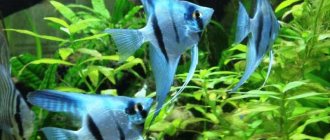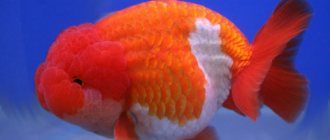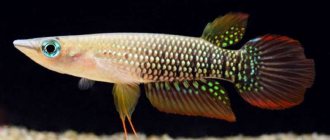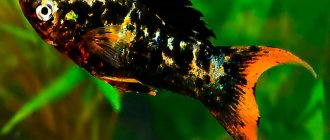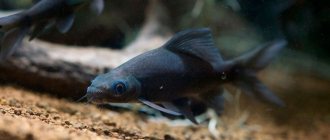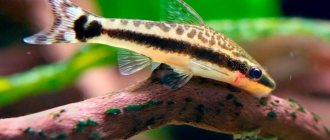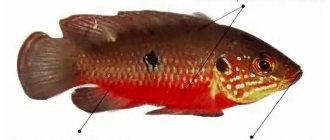Apteronotus white-bordered, or in other words black knife, is a freshwater aquarium fish from the Apteronaceae family. The black knife fish has gained popularity among aquarists since the 1980s. In its natural environment, it lives at the bottom of reservoirs in the Amazon forests. This type of fish is valued for its elegance and beauty. Suitable for experienced aquarists because it requires careful care.
In its homeland this species is especially valuable. Local residents believe that the soul of a person after death moves into the body of a fish.
Description
Aquarium fish knife is a weakly electric type. In reservoirs they live in turbid bottom waters, so they have learned to navigate in space by emitting impulses with an electric organ. The electric feature of the fish knife compensates for poor vision. The knife fish is a non-aggressive species, therefore it does not use its electrical ability for battles, but only for orientation, in extreme cases, for the purpose of defense against predators and representatives of its species.
Dimensions in nature reach 50–55 cm. In aquarium conditions, body size is 30–35 cm.
Appearance
Black knife is a black fish with two white stripes - one near the caudal peduncle, the second near the caudal fin. Has no scales. The body of the fish is flattened, long, and reaches quite large sizes. The dorsal and ventral fins are missing. They move using the anal fin. This fin extends from head to tail.
Behavior
The black knife fish is not a very active species. It will be stressful to be around active species. Leads a secretive lifestyle, hiding in algae and driftwood during the daytime. Shows activity only at night.
Although the body of the fish is not very flexible, thanks to its long anal fin, it is capable of performing various dexterous movements. For example, they have the habit of turning over with their stomach up, freezing without moving, and moving backwards.
Hunting habits
These fish are predators that hunt at night. They use their color as camouflage. They feed on small species of fish, insects and their larvae. Consider the carnivorous nature of the fish when choosing neighbors.
Habitat in nature
Apteronotus albifrons was first described by Carl Linnaeus in 1766. It lives in South America, in the Amazon and its tributaries. The scientific name is Apteronotus white-bordered, but more often it is called black knife. The name comes from English - Black Ghost Knifefish.
In nature, it lives in places with gentle currents and a sandy bottom, migrating to flooded mangrove forests during the rainy season.
Like most fish of its species, it loves densely overgrown places with lots of hiding places. In the Amazon, the places where Apteronotus lives are poorly lit and it has very poor eyesight.
To compensate for weak vision, the white-bordered one produces a weak electric field around itself, with the help of which it detects movement and objects. The field helps to hunt and navigate, but in addition, with the help of electricity, Apteronotus communicates with its own kind.
Black knives are nocturnal predators that hunt insects, larvae, worms and small fish in rivers.
For a long time, all apteronothus available for sale were exported from South America, mainly Brazil. But in recent years they have begun to be successfully bred in captivity, mainly in Southeast Asia, and the pressure on the wild population has dropped significantly.
Kinds
Aquarium fish knife includes not only black knife, but also some other species.
Black knife is a black fish with a flexible body and white stripes on the tail.
Glass or green knife (Eigenmannia vernacular) is a fish that looks like the blade of a knife or scalpel. There is no coloration, the body is translucent. It grows 20–40 cm in length.
Brown bronze knife. They differ from black knives in their coffee-brown color. There is often a white stripe on the forehead and back. They received their second name - long-nosed knives - because of their elongated and sharp nose. They have a timid temperament. Not suitable for beginners.
Eyed Indian knife (chitala ornata). The Indian knife is a silver-colored fish. A distinctive feature is the presence of white or dark circles on the sides of the fish. The body is long and flexible, there is a small hump. Leads a nocturnal lifestyle.
The African knife (black xenomist) is a pale silver-brown fish about 30 cm long. Unlike other knives, it breathes not only oxygen dissolved in water, but also atmospheric air. Leads a nocturnal lifestyle.
Amazing Features
An oblong process on a small and maneuverable tail plays a significant role in the life of a fish. On a process near the tail fin there is a special organ that emits electronic impulses.
In view of this, the knife is considered an individual of the electric fish family and produces a high-frequency magnetic-electric current with a low vibration amplitude.
There are small bump-shaped growths all over the body of the individual. They are receiving devices.
These capabilities allow the fish to easily navigate and find food in dirty water, and even at night.
Upon contact with a person, the fish will not receive an electric shock because its field is weakly electric.
Content
The content has some difficulties. Due to the lack of scales, the fish is sensitive to water parameters; they cannot be changed suddenly. And also be careful about the copper and zinc content. An ultraviolet sterilizer will help get rid of infections and many diseases.
Aquarium
These creatures require a large aquarium. There are about 150 liters per individual, but it is recommended to keep them at 400 liters. Equipment necessary for fish: external filter, compressor. The filter maintains cleanliness and cares for the aquarium by removing waste and food residues. The compressor aerates the water.
The aquarium must be equipped with a lid. Replace about a third of the tank's volume every week.
Water
The black knife is not too demanding on water conditions. But it is impossible to classify him as a pet that feels great in any conditions.
| Water temperature | 24–28 degrees |
| Acidity | 6–7 pH |
| rigidity | 5–15 dH |
Disease Prevention
Fish are very sensitive to diseases and the presence of drugs in water. To reduce the risk of developing diseases, you should install an external filter with a UV sterilizer in your aquarium.
The absence of scales in fish increases the risk of infection with ichthyophthyriasis, the distinctive features of which are:
- rashes on the skin in the form of small tubercles;
- stuck together fin on the belly, making movement difficult;
- swelling of the body surface.
If deviations appear in the behavior of the fish, you should seek advice from a specialist. Self-medication can lead to irreversible consequences and cause the death of the animal.
Emergency measures include the following:
- add Malachite green to the water, which does not contain zinc, which has a negative effect on the delicate skin of the fish;
- do not add salt to the water;
- before adding the product, replace 25% of the water volume in the aquarium;
- reduce the dosage by half;
- apply the medicine daily until the signs of the disease completely disappear and for two days to consolidate the result.
Breeding
Breeding these pets is difficult. For breeding you will need a separate 100 liter aquarium. For a higher chance of fertilization, place a female and two males in the aquarium. The water temperature needs to be increased a few degrees and the water level reduced. Gradually, over 2 weeks, raise the level. For spawning you will need several powerful sprayers capable of creating jets of water.
The female lays 350–500 eggs. The eggs are transferred to something like an incubator. The water level in it is 10–20 cm, without currents, in a dark place or in a place with weak light. After a few days, fry emerge from the eggs.
The difference between a male and a female
Males and females of this species are almost identical, sexual dimorphism is undeveloped. They are distinguished by several not very pronounced characteristics. The female is smaller in size than the male. Females have a more rounded abdomen, while males are more graceful and thin. Males have a fatty lump on their head.
Development of fry
Knife fish fry hide in dark places without access to light. The water should be saturated with oxygen and slightly salted. The fry feed on zooplankton contained in the water. After a month of life, they look similar to adults in a reduced form. They become capable of reproduction in a year and a half.
Compatibility
Black knife is a peaceful and non-aggressive fish species. When kept with other fish, knives get along well with medium and large fish that do not show aggression towards them. For example, with angelfish, clowns, aquarium parrots and unusual cichlids.
Does not get along with small fish species (for example, guppies, swordtails). They are perceived as live food. And also you can’t put several knives together, even different types. The fish will compete for territory and start fights. They are kept together only on the condition that each individual has more than 150 liters of water and a sufficient amount of food.
Feeding
The black knife is a predator fish that goes hunting at night. In nature, fish feed on insects, worms, snails, and small fish.
In the aquarium, the fish are fed live and frozen food. Suitable food for black knife:
- bloodworm;
- shrimp meat;
- Artemia;
- tubifex;
- fish fillet;
- squid.
Some aquarists feed their fish with ready-made tablet or granular food from the store.
The fish are fed in the evening or at night, in the dark, once a day. You cannot leave food in the tank; it is dangerous for the black knife to overeat. Due to overeating, the black knife can clog its intestines, which will lead to the death of the animal.
It is necessary to provide the black knife with a constant, varied diet. It is better to include dry and live food in the diet.
Diseases
The most common disease of black prince fish is ichthyophthyriosis or white spot disease. It occurs due to the absence of scales on the body. Ichthyophthyriosis is caused by parasitic ciliated ciliates.
Symptoms of the disease:
- The appearance of small tubercles.
- The anal fin loses its beauty and becomes frayed and stuck together.
- The fish moves slowly.
- The fish's body is swollen.
To select a drug for treatment, consult your veterinarian.
A more rare disease is acidosis, which occurs due to low acidity of water. The fish are slow, lethargic, and white spots appear on the body. Acidity is increased by baking soda.
Reviews
Aquarists like to keep these black pets in the aquarium, they add elegance and beauty to the aquarium. But some note that caring for them is somewhat difficult, especially when breeding. And also some breeders are not happy that the pet is constantly out of sight, often hiding, and you can only enjoy its beauty temporarily.


